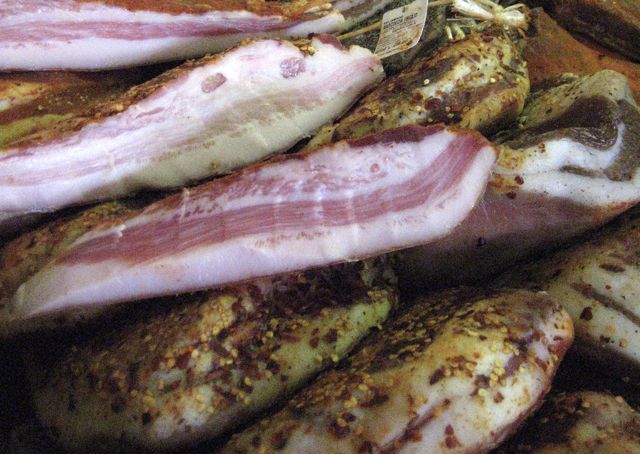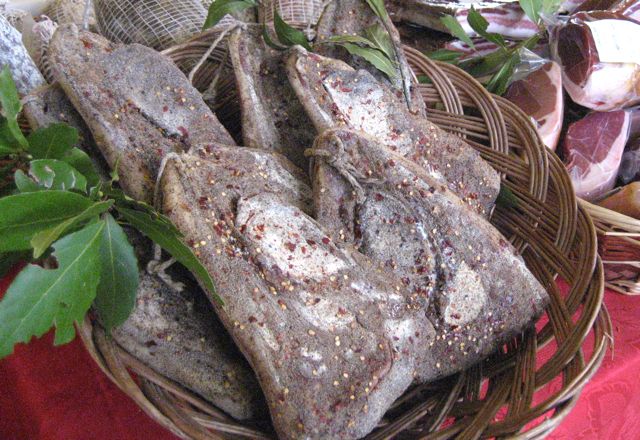
Since my name is Elizabeth, most people tend to shorten my name. I’m Liz to all my grad school friends, Lizzie to my sisters and nieces. I’ve even been called Kibbles (Bitsy > Bits> Kibbles & Bits)
But I think the nickname I’m most proud to wear is Guanciale Girl. My good friend Ari Weinzweig, the owner of Zingerman’s, came up with that one. Ari, along with Paul Saginaw, is one of the founders of Zingerman’s in Ann Arbor Michigan. What started out as a deli has since grown into an empire that includes a mail order business, bakery, creamery, restaurant and business training program.
Many of the great ingredients I mention in my blog are available through Zingerman’s. Actually a lot of them I discovered with Ari, toodling around on press trips through Italy or at the Salone del Gusto.
But getting back to Guanciale Girl. Ari is also a writer, and his most recent book is Zingerman’s Guide to Better Bacon. Yes, everything you ever wanted to know about Bacon but were afraid to ask. The section on guanciale – in which I am mentioned – has a very cute illustration of me, dressed in my Guanciale Girl outfit (at least that’s how the illustrator pictured me) complete with cape and tights.
What is guanciale you ask? Well, I”ll let Ari tell you in his own words. Here follows an excerpt from his Guide to Better Bacon along with his recipe for Pasta alla Gricia. And do you want to see me dressed in my GG outfit? Well, you’ll have to get a copy of the book. As a special porky treat, Ari has agreed to offer readers of my blog a 20% discount if you’d like a copy of your own. To order, you’ll find the link and information at the bottom of this post.*
Guanciale (from Zingerman’s Guide to Better Bacon, by Ari Weinzweig)
From a technical standpoint, guanciale isn’t bacon, either. Like lardo, it’s made from the wrong part of the pig: in this case, the jowl. But since it’s used in a recipe that regularly—if, most Italians will tell you, wrongly—calls for bacon, I figured it would be okay to mention it in passing. It’s certainly an interesting bacon alternative.
The name “guanciale” means “pillow” in Italian—a reference to its chewy meatiness and also to the shape of the whole piece of off- white cured jowl. “Cured jowl” probably sounds scary if you haven’t tried it, but since this book is directed at bacon lovers let me just say that you’ll want to get to know guanciale. Why? Because it’s porky, rich, velvety . . . because it’s good. It’s got pretty much everything most people love about good bacon: perhaps more intensely so, albeit without the smoke. If you need any more convincing, guanciale has been called “the magical Roman bacon.” That’s a pretty tough label for folks like us to resist. Personally, I was won over to guanciale thanks to Elizabeth Minchilli, a friend and food writer who has been living in Rome for many years. “I have become a guanciale girl,” she says. “I am so much happier cooking with guanciale instead of pancetta.” Yow. That got my attention. Forget the Prozac: just switching porks can increase life satisfaction? Who wouldn’t want to try it?
“What makes you so high on it?” I asked. “The fat is a different texture, and so takes longer to
get to that crunchy stage,” she answered. “And when it does, it still remains chewy and has a richer, meatier flavor. I use it for pasta— carbonara, amatriciana—but also with beans,” she went on. “I sometimes use it in spinach salad, as if it were bacon. This summer I was using it on all sorts of pizza. My favorite was goat cheese, sage and fried guanciale!”
As Elizabeth hinted, guanciale is the most authentic meat to use when you’re making pasta all’amatriciana. And there are a handful of very good guanciales on the American market: Niman Ranch cures its fresh hog jowls in sea salt for a month, spices them with rosemary, bay leaf, salt and pepper, and then air-dries them to complete the cure. Herb Eckhouse, too, has been making guanciale for the last few years. “We started making guanciale because we like eating it,” he told me. “Next thing we know, we can’t keep it in stock.” Like Niman’s, Herb’s is seasoned with salt and spices (most prominently rosemary and black pepper) and then dry-cured. He uses no nitrites, nitrates, vegetable juice or extracts. “The challenge,” Herb explained, “is getting the moisture out without making it overly dry.” He ultimately settled on a six-week cure, which he feels intensifies the flavor without creating something resembling shoe leather. Up in Seattle, Armandino Batali also makes a very good version. And there are a whole range of good restaurants that are curing their own now, too, perhaps most famously Babbo, the flagship establishment of Armandino’s son, Mario.
Ari’s Pasta a la Gricia
Serves 3 to 4 as a main course, 4 to 6 as an appetizer
This is one really great bowl of pasta, and the pepper is one of the key components of this dish, not a postscript, so use a lot of it.
The more I eat this dish, the more I like it.
Ingredients:
1 lb. spaghetti (I’m partial to Martelli, but you can pick from any of the
great artisan brands including Latini, Rustichella and Cavalieri)
5 ounces guanciale, cut into quarter-inch dice
Red pepper flakes to taste (I use the Marash red pepper flakes from Turkey)
Freshly ground Tellicherry pepper to taste
5 ounces Italian Pecorino Romano cheese, finely grated
Bring a large pot of water to a boil. Add a generous amount of salt.
At the same time, begin heating a heavy 12” skillet over medium-high heat.
Add the pasta to the water and stir so that the noodles don’t stick.
Fry the guanciale in the skillet until its fat is released and the nuggets begin to crisp. (If your guanciale is too lean, add a bit of olive oil to the pan.)
When the pasta is approaching but not quite yet al dente, remove from the heat and drain.
Add the pasta to the skillet with the guanciale and toss well to coat with the hot pork fat. Cook over medium heat for about 2 minutes, until the pasta is fully al dente. Stir regularly so that the pasta doesn’t stick. Add red and black pepper liberally to taste.
Turn off the heat, add the grated Pecorino cheese and toss to coat. Serve hot, and pass the pepper grinder.
Variation:
In the spring, sauté 6 ounces of asparagus, cut into one-inch pieces, along with the guanciale. I like the asparagus pieces lightly browned to bring out their full flavor.
*To order your very own copy of Zingerman’s Guide to Better Bacon click here, and type in this discount code: MINCHILLI and that will take 20% off your order (not including tax and shipping). The offer is valid until 2/28/2011.
Leave a Reply (comments are moderated)